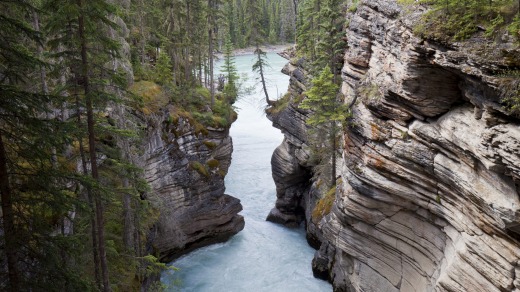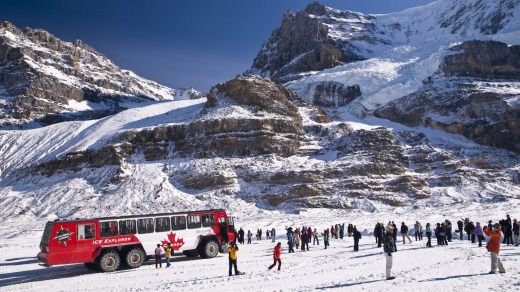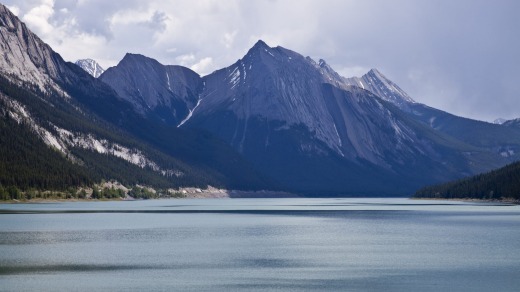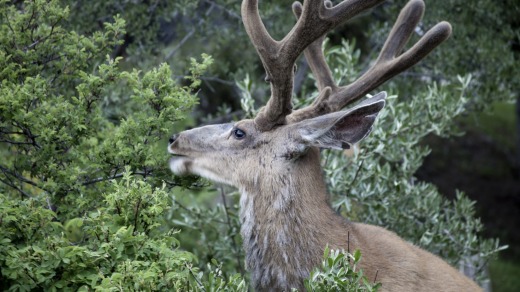Dusk, early September. In the twilight, two men on horseback sidle up beside a freight train stopped at a red signal. They wear bandannas pulled across their faces, brandishing pistols as they close in on their target. Bill Miner, the leader, an ex-con fresh out of San Quentin Prison, fires a single shot into the air before holding up a train guard at gunpoint.
Never raising his voice, he orders the guard to separate the carriages, wielding a stick of dynamite he threatens to light should the guard have other ideas. Reluctantly the man does as he's told and, as the front half of the locomotive recedes into the distance, Miner and his accomplice William "Shorty" Dunn pull off Canada's first train robbery, escaping with a bounty of gold dust and US bonds worth about $2 million in today's currency.
Rattling out of a tunnel, horns blazing, our train passes the exact site where these events unfolded back in 1904.

I'm on board the Rocky Mountaineer and as I'm fast learning, colourful historical anecdotes such as that of the "Gentleman Bandit" are not in short supply.
We're sitting on the upper deck of a two-tiered carriage inside what is essentially a cylindrical glass dome. On one side, the glacial turquoise waters of the Kicking Horse River slice through an embankment of lush pine and spruce trees, on the other, the snow-capped peaks of the Rocky Mountain range grow steadily in stature.
It's still early and pots of fresh coffee and warm baked scones are making the rounds. Having just pulled out of the small industrial town of Kamloops, we are winding further east towards the winter playground capital of Banff midway through a route known as "First Passage to the West".

There's a faint air of anticipation on board, a low hub of animated conversation, our hosts wandering the aisles serving drinks, making wisecracks or imparting words of wisdom about the region over the microphone.
In many ways, luxury train travel on the Canadian Pacific track is still a relatively new concept. This year marks Rocky Mountaineer's 25th anniversary and, though 10,000 passengers were hosted in the inaugural year alone, the real game changer came in 1995 with the launch of Gold Leaf service.
Within the space of 12 years, 16 custom made bi-level domes were created for passengers to further enjoy the scenery of the majestic Canadian Rockies, capitalising on the glass viewing dome up top, with a fully equipped galley, kitchen, dining room and outdoor vestibule beneath.

Heading downstairs – meals take place in two alternating shifts, the latter placated with the aforementioned coffee and scones at breakfast, wine and cheese at lunch – we sit down to breakfast in a dining cart that's something like a moving IMAX screen crossed with The Ritz.
Beside expansive "picture windows", cushioned booths face tables furnished with crisp white linen tablecloths, silver cutlery and pristine glassware. The menu, a bold navy with gold trim to match the train's theme, contains a quote from Julia Child on the reverse, "People who love to eat are always the best people."
Just as well. Ordering the "Gold Rush Scramble", eggs with smoked salmon topped with kelp caviar and lemon chive crème fresh, I enjoy a breakfast that would be impressive enough in a top city restaurant, let alone one prepared in a cramped, moving kitchen. It's no coincidence the dining, under the stewardship of celebrated executive chef J.P. Guerin, has become a definitive hallmark of the Rocky Mountaineer experience.

As the day progresses, we wind ever higher into the Rocky Mountains, passing the glassy waters of the Adams River, one of the most important salmon breeding grounds in the world. Throughout the journey the landscape is forever shifting, from the stark grey granite cliffs and desert plains that preceded Kamloops (our first overnight stop) to plunging gorges, snowy alpine peaks, forgotten lumber towns and raging rivers.
It's a passage steeped in history, from intrepid pioneering explorers such as Simon Fraser, who navigated much of the area with the help of First Nations communities, to the hungry, hardworking miners who came seeking elusive fortunes in the ubiquitous gold rush towns of the 1800s.
All of it is brought to life over the microphone by our team of hosts; skilled raconteurs selected more for their extroverted personalities than hospitality background. Many are avid rock climbers, snowboarders and seasonal lifestylers alternating working summers with winters spent traversing the globe in search of the next big adventure.
"A lot of work goes into selecting the right people," train manager David Aboud says. "The crew love what they do, I think that makes a massive difference to the overall experience, it really carries over to the guests."
Said guests are a mixed bunch. Most are train fanatics, realising a bucket-list dream having already embarked on other iconic rail odysseys around the world. Others are using the route as a means to explore parts of Canada that would otherwise be largely inaccessible, while some are passionate photographers.
Though it's tempting to kick back and enjoy the dangerously steady flow of wine and "Caesars" – Canada's much-loved answer to the Bloody Mary – I spend much of my time in the outdoor vestibule jockeying for prime Kodak vantage points. Passing bald eagles hovering in our jet stream, wild mountain goats, elk and even a fleeting glimpse of a black bear, the hours pass quickly.
It's perhaps just as well as the days are undeniably long. With few towns in the area capable of offering the level of infrastructure befitting such a high-end experience, often we travel for up to 12 hours at a stretch, thanks mainly to inevitable pauses for passing freight trains and an average speed of just 50km/h.
When we do roll into towns – the Rocky Mountaineer travels only by daylight with overnight hotel stops to maximise scenery – considerable thought has gone in to minimising aggravation.
Room keys are usually handed out on board, thereby avoiding a short-tempered scrum at check-in, while each morning we simply leave our luggage in the room, where it will magically appear again at the following night's accommodation.
It's these periods off the train that are part of Rocky Mountaineer's strength, allowing us to mix up the experience with less sedentary periods.
In Banff, I wander the local museums, hire a mountain bike and bathe in the outdoor hot springs. In Jasper, I ride a vintage Harley up to a lake so ludicrously powder blue it looks as though divine Photoshop intervention has played a part.
And between the two towns I navigate the only stretch of my journey by road, cruising the impossibly scenic Icefields Parkway, before grinding up the Athabasca Glacier on a monstrous, hydraulic-powered truck known as The Ice Explorer.
Nowadays there are five Rocky Mountaineer routes traversing parts of the Rockies, making it possible to explore much of this region by train, with lengthier stopovers. But with time against me, I opt to rejoin in Jasper, embarking on the Rainforest to Gold Rush route.
Initially heading west, we veer south towards Quesnel.
Peaking at almost 4000 metres, the train carves a spectacular path past Mount Robson, the highest peak in the Canadian Rockies. This leg offers a rapidly changing, diverse backdrop to rival my first leg between Vancouver and Banff; winding between the snow-dusted Coast Mountain Ranges, the desert-like Fraser Canyon and lush ranches of the Cariboo Plateau.
Again, our hosts play a significant role. At Penny we pass a post office resembling a shotgun shack where the 32 residents are embroiled in a passionate battle to save it from the wrecking ball. We hear poems such as the deliciously black Cremation of Sam McGee and song excerpts, all of which vividly bring the gold rush history to life.
It's one reason the increasingly popular route will be amalgamated to three days, incorporating Vancouver (now a separate day trip) as of next year.
On our final night we stop in Whistler, home of the 2010 Winter Olympics.
Wandering the streets, I'm surrounded by adrenalin-junky mountain bikers dressed in full-body armour, GoPro cameras strapped to their crash helmets.
It's an undeniably gorgeous setting, a fantasy land of adventure but I feel strangely alienated amid the vaguely artificial air and obvious clique.
Once again I find myself yearning for the perpetual motion of the train, the liberating sense that comes with being constantly on the move.
The journey it seems has indeed become the destination.
MORE INFORMATION
See canada.travel
GETTING THERE
Qantas offers three direct flights a week between Sydney and Vancouver during the US summer and winter periods. See qantas.com
TOURING THERE
For 2016, Rocky Mountaineer offers more than 45 vacation packages and five unique rail routes across three levels of service. The First Passage from the West starts at $1898 per person while the newly expanded three-day Rainforest to Gold Rush route starts at $2624. See rockymountaineer.com/en_AU
VISIT THE NOBLE PIG If you're on the First Passage to the West, on your first overnight stay in Kamloops, be sure to check out the delightful range of beers and rustic cuisine at this local brew house. See thenoblepig.ca
KICK BACK IN STYLE In Alberta's stunning Jasper National Park, the Fairmont Jasper Park Lodge faces the pristine Lac Beauvert (lake) and is the perfect base for golf, kayaking, mountain biking or ice-skating and skiing in winter. See fairmont.com/jasper
TAKE AN UNUSUAL TOUR The fire hydrants throughout Quesnel have been painted up as local historical figures. Learn the backstory of each on a self-guided walking tour. See downtownquesnel.com/uploads/Little-People.pdf for the map.
HANG WITH THE STARS Explore the galaxy through state-of-the-art telescopes while listening to astronomers at the Jasper Planetarium. See sundogtours.com/package/planetarium-and-stargazing/
RIDE THE HIGHEST PEAKS Take in 360-degree views of Whistler as well as glaciers, lakes and forests with a ride on the famed Peak 2 Peak Gondola. See whistler.com/activities/peak-to-peak-gondola/
See also: One day, three countries, two trains